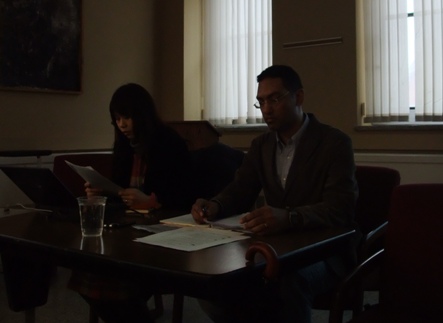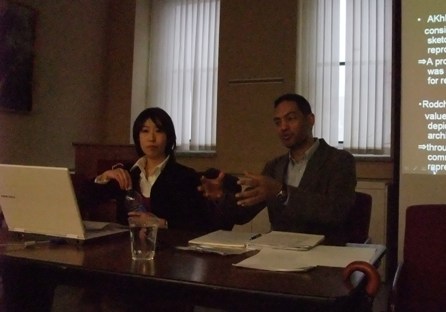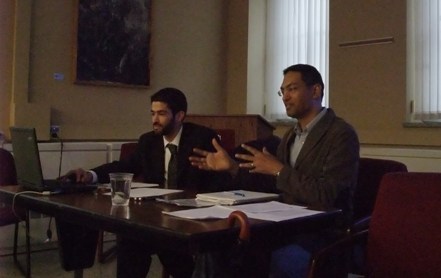[Report] Workshop: Image as History
The conference ‘Image as History’ was held on February 27th in University of Ottawa. Three members from Ways of Image, one of the 短期教育プログラム(Short-Term Educational Programs) at UTCP, IDO Misato, SAKAGUCHI Sayaka and KAWAMURA Aya, presented their papers in a panel session, along with Professor Eric Allina-Pisano, who teaches African History at the University of Ottawa. This conference was organized by Viren Murthy (Department of History, University of Ottawa), who visited UTCP last summer for his research, in cooperation with Kouky Fianu from the University of Ottawa’s program of Medieval and Renaissance Studies.
 (Parliament Hill, Ottawa)
(Parliament Hill, Ottawa)
IDO Misato (UTCP)
'The Meaning of visualized landscapes: Contextualizing Depiction of Seasonal Changes in Patterns of Life on Medieval Japanese Folding Screens
Ido Misato’s presentation discussed the Japanese folding screen titled ‘Tsukinami fuzoku-zu byobu’ (Seasonal Changes in Patterns of Life). First of all, by analyzing the historical documents which were handed down to local areas by the Kikkawa clan, it is possible to conclude that this folding screen was commissioned by that clan. Moreover, through research into the events that are described in the folding screen, we find that its subjects and motifs greatly differ from other paintings of that time. The depicted landscape might be closely connected to the territory of the Kikkawa clan. The depicted landscape which is shown throughout the four seasons would thus be a kind of utopia, which the commissioner of the painting, the Kikkawa clan, yearned for.
SAKAGUCHI Sayaka (PD, JSPS)
The Emperor Transfiguring Himself: A Study of Portraits of Rudolf II.

Sakaguchi Sakaya’s presentation dealt with portraits of the Holy Roman Emperor Rudolf II (b. 1552; 1576-1612). She classified his portraits into three types. First, she analyzed a beautiful image of the new emperor succeeding the authority of the ancient Roman Empire, created by the medalist Antonio Abondio. Second, she discussed an image of the strong emperor defeating the Turks and bringing peace to the empire, created mainly by the engraver Aegidius Sadeler and the sculptor Adriaen de Vries. Third, she analyzed a magical image derived from the idea of a golden age and natural magic, represented by Giuseppe Arcimboldo’s Vertumnus. After an interpretation of the portraits based on this classification, she considered their effects. Rudolf’s transfiguration in the portraits was a process of presenting him not as human but as “the emperor Rudolf”.
KAWAMURA Aya (UTCP)
Images that Make History: Lenin’s “Photographic” Representation in the Era of the Lenin Cult

Kawamura Aya’s presentation discussed the Lenin Cult which occurred shortly after his death. During the time of the Lenin Cult, artists tried to produce images of Lenin. She analyzed two types of visual representations of him: official and idealized representations produced by sculptors and the AKhRR painters, and private and documentary representations by “Lef” artists. Painters of AKhRR tried to create monumental and “synthetic” portraits of Lenin in the traditional manner of realism. Isaak Brodsky, one of the AKhRR painters, used the photographs as a technical substitute for a sketch when they depicted Lenin. Lenin’s portraits by AKhRR artists were reproduced by photography, and they were distributed all over the country. On the other hand, members of the journal “Lef” were against the idealization of Lenin. In the project of Alexandr Rodcheno’s Lef Archive and in the series of History of VKP(b) [all Russian Communist Party (Bolshevik)], he tried to make use of photography as well as visual documentary. Focusing on the use of photography, Kawamura examined how artists struggled to represent the revolutionary leader, and tried to show how images make power and history through the example of revolutionary Russia.
Eric Allina-Pisano (University of Ottawa)
Fallacious Mirrors: Colonial Anxiety and Images of African Labor in Mozambique

Professor Allina-Pisano, who is working on African social history in the colonial period, discussed images of African labor in Mozambique, especially focusing on photographs that were exhibited at colonial exhibition in Paris in 1931. At that time, European countries criticized Portuguese colonial policy for depending on forced labor. Professor Allina-Pisano argued that with albums with many photographs of African workers in Mozambique, the Portuguese tried to represent the accomplishment of civilizing and bringing progress. More specifically, they demonstrated the physical, moral, intellectual, and social development of the natives. Images in the albums reflect the eyes of the period and historical consciousness, and the ways in which interwar Europe, saw African workers in the context of colonial modernity.

(IDO Misato)






